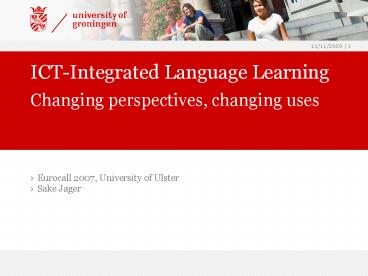ICTIntegrated Language Learning - PowerPoint PPT Presentation
1 / 18
Title:
ICTIntegrated Language Learning
Description:
Pedagogy: Conversational Framework. Technology: Media properties ... Pedagogy: Facilitation of ... teaching and learning, ICT secondary ( pedagogy first' ... – PowerPoint PPT presentation
Number of Views:36
Avg rating:3.0/5.0
Title: ICTIntegrated Language Learning
1
ICT-Integrated Language Learning
- Changing perspectives, changing uses
- Eurocall 2007, University of Ulster
- Sake Jager
2
Outline
- ICT-integrated language learning
- Language innovation project University of
Groningen - Presentation of some materials developed
- Discussion and questions
3
Integration
- Oxford Advanced Learners Dictionary
- Technology and language learning things to be
combined in CALL - Integration should also take into account other
aspects, such as educational environment - General framework provided by Collis and Moonen
(2001)
4
Key components technology-enhanced learning
Based on Collis Moonen (2001)
5
Key components in relation to other studies
- Implicit or explicit reference to components
- Laurillard (2003)
- Pedagogy Conversational Framework
- Technology Media properties in support of CF
- Institution Effective organisational
infrastructure - Barr (2004)
- Pedagogy Facilitation of learning approaches
- Technology Technical sufficiency, integrated
infrastructure - Institution Growing a culture, time, human
resources, strategic planning
6
Key components in relation to other studies
- Taalas (2005)
- Pedagogy Add-in uses rather than add-on uses
- Technology Multimodal learning environments
- Institution Staff development, transformation of
teaching practices
7
Integration vs normalisation
- Normalisation, Bax (2003)
- stage when the technology becomes invisible,
embedded in everyday practice and hence
normalised (23) - End goal of CALL
- See Levy and Stockwell (2006) for discussion
- Integration is a continuous process rather than
an end goal - As new technologies emerge, new forms of
integrating technology, pedagogy, institutional
aspects are required - Field of CALL as a whole will never reach a state
of normalisation
8
Technology, Pedagogy, Institutional context
- Much CALL research technology-pedagogy
interface - What technical attributes specific to the new
technologies can be profitably exploited for
pedagogical purposes? (Salaberry 2001) - Results not always applicable in real
situations - Teacher-researcher extra effort (CALL for
research) - Controlled vs uncontrolled use
- Whole range of programs
- Lack of funding
- Incompatible views on language learning
- Standardization and rigidly controlled
infrastructure
9
Taal Vaardig (Ready-for-languages) project
- Aims to change language learning in University of
Groningen by - Restructuring language learning programmes
(courses/modules) - Re-thinking teaching practices
- Reinforcing the use of technology.
- Over 30 language teachers from
- Academic language departments and the university
language centre - All languages taught as part of the curriculum
- Phase 1 (2006-2007)
- English, Spanish, French, Italian and German
- Phase 2 (2007-2008)
- Finnish, Hungarian, Russian, Swedish, Danish,
Norwegian, Hebrew and Arabic
10
Project background
- Motivated by aspects from each of the dimensions
identified earlier - Institution
- Strengthen collaboration between language centre
and language departments - Offer language modules as part of flexible
Ba-programme (30 EC) - Staff development (language teaching methodology
and ICT) - Pedagogy
- Apply CEFR in language programmes
- More task-based, communicative language learning
- Technology
- Blackboard course for each module
- Blackboard for exchanging and consolidating
materials - Increase autonomous learning (self-study) through
technology - Integrate newly established multimedia language
labs
11
Project design
- Commitment Faculty Board
- Participation departments mandatory
- Implementation mandatory
- Only permanent staff involved
- University funding
- Teachers released from other tasks for 1 day/week
for 1 year - New infrastructure for ICT-enhanced learning
available at start - Focus on language teaching and learning, ICT
secondary (pedagogy first) - Language teams same language, mixed backgrounds,
mixed abilities, catering to different target
groups (cross-fertilization) - Teacher training and curriculum development
combined (immediate relevance) - Negotiated programme, contributions by teachers
themselves, learning from one another - Blackboard as medium for supporting the project
(teach as you preach) - Real outcomes re-designed modules for use in
2007-2008 (high stakes)
12
Project coverage
- Topics studied and discussed
- Application of the CEFR
- Learner autonomy
- Evaluation and assessment
- Spoken interaction in the curriculum
- Teaching grammar
- Teaching writing
- Teaching vocabulary
- Hands-on ICT sessions
- Module design
- Coverage of CEFR skills in the curriculum
- Curriculum / Module descriptions
- Materials development in Blackboard
- Modules 5 / 10 EC
- 4 / 8 hrs teacher time p.w.
- 6.5 / 13 hrs student time p.w.
13
Teacher evaluation
14
Teacher evaluation (contd)
15
Project evaluation
- Positive
- Large-scale innovation many modules, all
languages, all teachers - Re-use of materials between modules
- Contacts between language teachers
- Increased understanding of critical issues
- Climate for language teaching
- Increased use of technological infrastructure
- Uncertain
- Adaptation of materials by colleagues
- Differences in ICT-skills remain
- Differences in quality of design
- Structural collaboration between language centre
and language departments - Appreciation of materials by students
16
Examples of materials developed
- English minor
- Spanish IEB
- French major
17
References
- Barr, David. ICT - Integrating Computers into
Teaching Creating a Computer-Based Language
Learning Environment. Bern Peter Lang, 2004. - Bax, Stephen. "CALL - past, present and future."
System 31 (2003) 13-28. - Collis, Betty and Jef Moonen. Flexible Learning
in a Digital World. Abingdon, Oxon
RoutledgeFalmer, 2001. - Laurillard, Diana. Rethinking University Teaching
2nd Edition A Conversational Framework for the
Effective Use of Learning Technologies. 2nd
edition ed. London Routledge Farmer, 2002. - Levy, Mike and Glenn Stockwell. CALL Dimensions
Options and Issues in Computer-Assisted Language
Learning. ESL Applied Linguistics Professional
Series. Lawrence Erlbaum Associates (Bks), 2006. - Salaberry, M. Rafael. "The Use of Technology for
Second Language Learning and Teaching A
Retrospective." The Modern Language Journal 85.i
(2001) 39-56. - Taalas, Peppi. Change in the Making Strategic
and Pedagogical Aspects of Technology Integration
in Language Teaching - Towards Multimodal
Language Learning Environments. Jyväskylä Centre
for Apllied Language Studies, 2005.
18
Thank you for your attention































